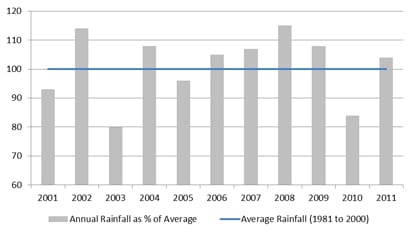- The East Midlands, London and South East face particular risk
- Dry summer would cost homeowners £291m
- Rainfall levels for the whole of 2012 were 15% above average
- Similar levels of rain over the past decade have led to increased cases of subsidence
- 6.5m UK homes at risk of shrink/swell subsidence
- Subsidence has cost UK homeowners £3bn over the last ten years
A dry summer in 2013 would cost UK homeowners over £291m in damages due to shrink/swell subsidence following record rainfall in 2012, according to SearchFlow, the property search provider.
2012 was the second wettest year on record[i], with total rainfall for the year 15% higher than the annual average[ii]. If 2013 turns out to be a very dry year, there is a risk that subsidence cases could surge. Long range forecasters are already predicting a dry, hot July and August[iii].
According to the British Geological Society, the preceding two years of rainfall have a strong influence on ground saturation in any given year. Clay soils swell when saturated but when dryer weather causes evaporation these soils can shrink, crack and cause subsidence in properties.
In the ten years to 2011 there were two periods of particularly high rainfall which were followed by very dry years.
In 2002, 14% more rain fell than in a normal year. This wet period was followed by a very dry year – in 2003, rainfall was down 20% from the average.
Rainfall during 2008 and 2009 was 15% and 8% above average. This long, extended period of high rainfall was followed immediately by a dry 2010, when yearly rainfall was down 16% on the annual average.
In the dry years that followed these wet periods, subsidence claims rose by nearly a third (31%)[iv] on average.
Richard Hinton, business development director of SearchFlow, said: “Heavy rainfall and ground saturation leads to swelling in the soil, particularly in areas with high levels of clay. If this is followed by a very dry spell the soil dries, shrinks and can crack. This can be a big problem for properties built on this type of soil. We’ve had a particularly wet couple of years with 2012 the second wettest on record. If the UK has a very dry summer this year it will certainly lead to a surge in subsidence issues for homeowners.”
The Cost of Subsidence
Since 2001, subsidence has cost UK homeowners £3bn in repairs[i]. With over 220,000 cases of subsidence over this period[ii], the average cost per case is just over £13,600. In 2012 there were an estimated 16,500 cases of subsidence[iii]. If the UK were to experience a particularly dry 2013, similar to 2003 and 2010, the number of cases could rise to 21,365 this year[iv] at a cost of £291m to UK homeowners.
Richard Hinton, said: “Clay soil is prevalent in the North, London and the South East and properties in these areas are particularly susceptible to subsidence issues. Peace of mind is important for those hoping to buy property in these areas, especially when there has been two years of above average wet weather. Buyers should be asking their conveyancer to check the risks associated with subsidence. There’s nothing more precarious than making the biggest purchase of your life without all the facts in front of you.”
A Wet 2013
If 2013 turns out to be another wet year for the UK, the issue of subsidence could be multiplied further if 2014 is a particularly dry year.
Richard Hinton, said: “If we have another year of heavy rain, the can will simply be kicked further down the road. Further swelling of clay soils will lead to more acute shrinkage if 2014 is a dry year. Damage from subsidence costs UK homeowners more each year than flooding so owners and buyers need to be aware of the risks their properties face from the outset. Otherwise they could be sitting on a ticking time-bomb.”
For more information on any of the reports available through Searchflow, please visit www.searchflow.co.uk
[i] Figures from Property Assure
[ii] 2001 to 2011 subsidence claims figures (after repudiation) from the Association of British Insurers
[iii] Figure estimated by Cunningham Lindsey
[iv] Based on the average increase in subsidence cases seen in 2003 and 2010
[ii] Comparison with the average annual rainfall between 1981 and 2000 (Met Office Statistics)
[iv] Subsidence Claim figures from the Association of British Insurers











